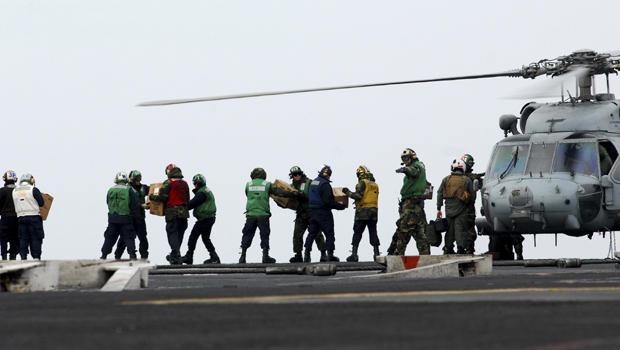U.S. troops mobilized for Japan relief efforts
As U.S. military ramps up humanitarian efforts in Japan, the Pentagon has said U.S. troops working on relief missions can get closer than 50 miles to the Fukushima Dai-ichi nuclear complex, disabled by last week's tsunami, with approval.
Pentagon spokesman Col. Dave Lapan said the U.S. would review requests from the Japanese for assistance that would require troops to move within that radius, though no approval for such movement had been given since the stricter guidelines were enacted. The Obama administration has urged the evacuation of Americans from a 50-mile radius of the stricken nuclear plant, raising questions about U.S. confidence in Tokyo's risk assessments. Japan's government was urging people within 20 miles to stay indoors if they could not evacuate.
The Pentagon said troops are receiving anti-radiation pills before missions to areas where radiation exposure is likely.
"U.S. forces remain in Japan and the U.S. has full capability to fulfill our alliance commitments to defend Japan and maintain peace and security in the region," Lapan said.
Complete coverage: Disaster in Japan
U.S. offers evacuation flights from Japan
U.S., Japan set different evacuation standards
With the arrival of three more ships to the massive humanitarian mission, there were 17,000 sailors and Marines afloat on 14 vessels in waters off Japan. Several thousand Army and Air Force service members already stationed at U.S. bases in Japan have also been mobilized for the relief efforts.
Airmen have been flying search and rescue missions and operating Global Hawk drones and U-2 reconnaissance planes to help the Japanese assess damage from the disasters. The operation is fraught with challenges - mainly, figuring out how to continue to provide help amid some low-level releases of radiation from the facility, which officials fear could be facing a meltdown.
Snow and poor visibility continued to limit helicopter operations Thursday, but helicopters from the USS Ronald Reagan strike group and Carrier Airwing Five in Atsugi delivered 10 tons of food and water to relief sites ashore, reports CBS News' Mary Walsh.
The carrier USS George Washington, which is undergoing repairs at Yokosuka has sent 100 nuclear-biological-chemical firefighting suits and masks for use at the Fukushima site, reports CBS News correspondent David Martin. The United States has also sent five high-pressure water pumps from its naval facility at Sasebo to Fukushima.
The Pentagon is sending an assessment team to Japan to see whether a much larger military unit, called the Chemical Biological Radiation Nuclear and Engineering Consequence Response Force is needed. If the nine-person assessment team decides more forces are needed, it would likely involve several hundred members of the Response Force who are trained in working in a contaminated environment. They would not be involved in shutting down the reactors, simply in decontamination.

